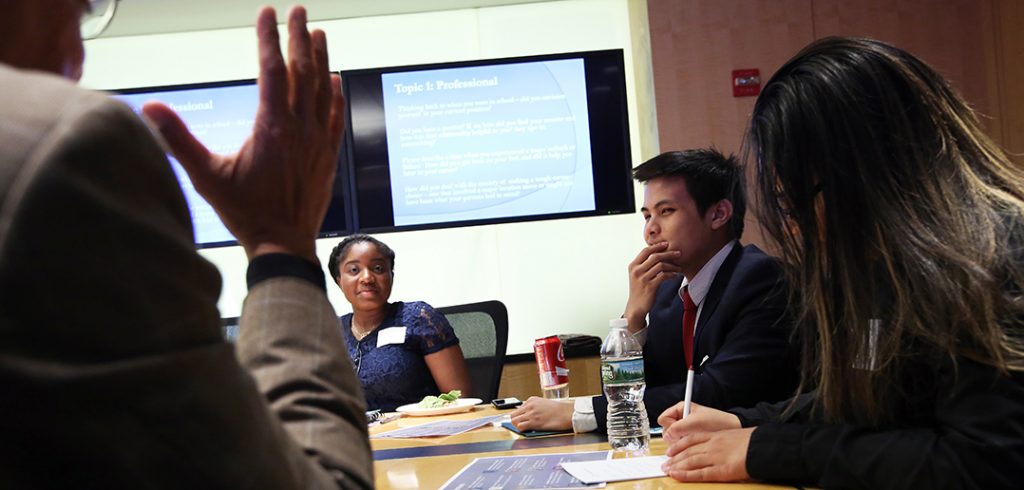



Fordham students welcomed Vice President Kamala Harris to New York City when she arrived at LaGuardia Airport on Air Force Two on April 14.
The vice president was in town to attend the National Action Network’s 2023 Convention. Two days prior to her arrival, her office reached out to Fordham to invite students to meet her.
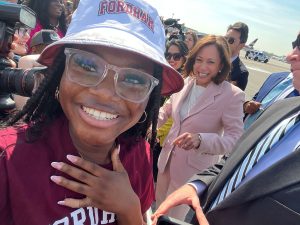
Claudia Dabie, a Fordham College at Rose Hill student and a member of Fordham’s Collegiate Science and Technology Entry Program (CSTEP) program, said the moment when Air Force Two landed was “so majestic.” Then the vice president approached the Fordham group.
“She started walking towards us, and she started saying hi. And she was smiling and she’s so nice,” said Dabie. “It was amazing. I loved it.”
Lesley A. Massiah-Arthur, associate vice president and special assistant to the president for government relations at Fordham, said that when the invitation was extended, she jumped at the chance to recruit as many Fordham students as possible.
By reaching out to CSTEP, as well as Fordham’s Higher Education Opportunity Program, the Center for Community Engaged Learning, the Office of Student Involvement, and several members of the Fordham faculty, she was able to send a list of interested students and arrange for transportation from both campuses with the generous support of the office of Fordham President Tania Tetlow.
Massiah-Arthur submitted the names of 135 students and around 70 received invitations from The White House. She said that officials in Harris’ office were so impressed with Fordham’s quick and enthusiastic response, they will be inviting the students who did not receive an invitation to this event to a future event when the vice president returns to New York City.
The invitation is a testament to the University’s standing, she said.
“I still remember to this day the first opportunities that I had to engage with elected officials, and I think it’s important that students get those opportunities,” she said.
“So when this opportunity came up, I didn’t think that it was something we could pass up. Regardless of your political affiliations or your beliefs, there should still be a fundamental belief that engaging in a political dynamic and engaging in democracy is the best way of affirming change. By participating in this opportunity, we’ve taken one more step in doing that.”
—Video by Hector Martinez
]]>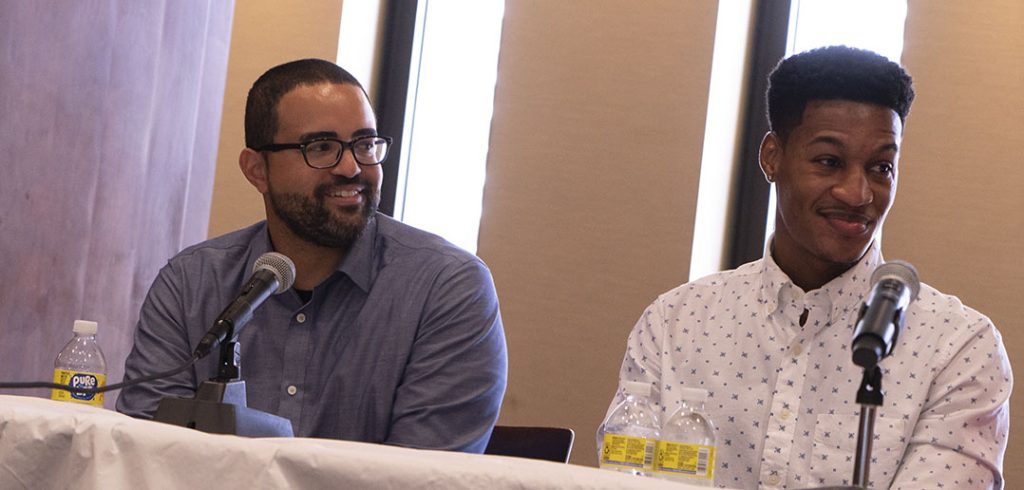
HEOP, a New York state-administered program, provides support services for students who show potential for success. Most of Fordham’s HEOP students hail from the five boroughs and are, in many cases, first-generation students. They are a pretty proud bunch, said Colin Hyles, FCLC ’19, a senior administrator at Sales Force. But he told the students to not let their pride hold them back from asking for help.
“HEOP is a great support, I’d go as far as to say family,” Hyles said. “A lot of us, we’re so proud, and we think, ‘I can’t show weakness.’ But put that pride aside and ask for help when you need it. There’s no judgment here.”
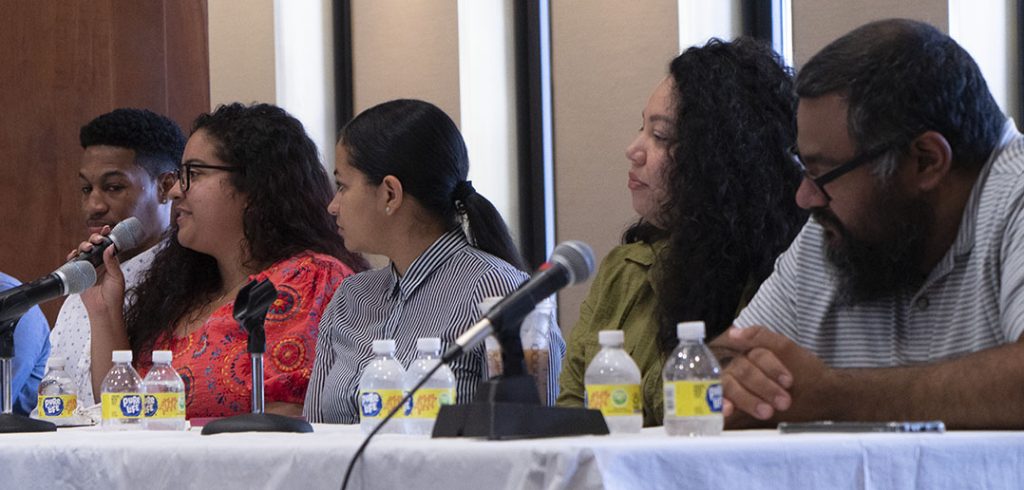
Larry Cerpas, FCLC ’09
Hyles spoke on a panel with six other Fordham HEOP alumni, held on Aug. 2 at the Corrigan Conference Center on the Lincoln Center campus. The welcome event allowed incoming students to network and exchange contact information with alumni.
Panelist Anissa Nuñez, FCLC ’22, who is perusing her Master of Studies in Law in corporate compliance this fall at Fordham Law, agreed with Hyles.
“You develop relationships with the counselors, some become longtime friends,” said Nuñez. “If you ever feel that you’re lost you can always drop into the office. Students can always come in and express themselves.”
That said, all the panelists encouraged the students to not lean on the familiar surroundings too heavily.
“Don’t limit yourself to your culture, this is the time when you have to transition from a high school kid into an adult,” said Jennifer Vasquez, FCLC ’09, a lawyer who works in data risk and governance at Capitol One Bank.
Vasquez encouraged students to join clubs that aligned with their interests and encouraged them to seek out similar clubs at the Rose Hill campus.
In order to succeed in their careers, students must keep their eye on the ball while they’re in school, said panelist Larry Cerpas, FCLC ’09, a content producer and filmmaker.
“Learn to set boundaries; it’s OK to say no,” said Cerpas. “On a social level you’ll want to go out and party and that’s more than OK, but sometimes you’ll have to say no.”
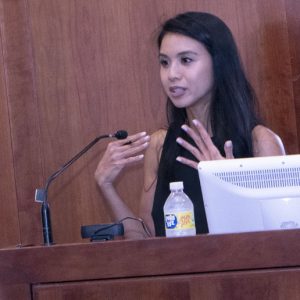
associate at Eversheds Sutherland LLP, advocated for the panel and moderated the discussion.
Nuñez recalled that she never said no and had to struggle with time management.
“I worked for years on time management and it was really hard; I tried to adjust my schedule two or three times. You really have to navigate your methods,” she said.
Vasquez reminded students that an education from Fordham is a privilege. Not only should they learn to say no to classmates, she said, but they should also learn to say no to friends from the neighborhood and even to their family when need be.
“Don’t let anyone hold you back,” she said.
Kelly Sosa, FCLC ’10, assistant director of residential life at Lincoln Center who spoke on the panel, agreed that HEOP should be considered a foundation so that students feel comfortable exploring all the University has to offer.
“Explore Fordham. This is your base, but please do not just stay here,” said Sosa. “You will get to meet a lot of individuals with a lot of different backgrounds. Don’t miss out on that.”
Sosa recalled horseback riding in Montana at the invitation of a classmate when she was at Fordham. She said that she would have missed out on that experience and many other experiences had she not stepped out of her comfort zone.
“Get comfortable with being uncomfortable,” said Hyles, in a line that resonated with several of the students in the audience.
Incoming first-year student Brianne Cepeda, who just graduated from the Urban Assembly Maker Academy in Manhattan, said she was not expecting to hear such advice.
“It makes sense to be uncomfortable so, you know, you can make yourself find your new comfort,” she said.
Nevertheless, Brooklyn Tech graduate Alsou Kim said she found the panel “comforting.”
“Sometimes you don’t think you’ll be able to make it as an adult,” said the first-year student. “I mean, it was just two weeks ago that I was in high school. But it was cool to see people who were in our position before and see they were able to succeed.”
]]>The state was North Carolina, and many of the people he met there were immigrants who had suffered greatly before coming to work at the cooperatives that he was visiting with other Fordham students. Listening to their stories “just put a lot of things into perspective for me,” he said.
Grullon is one of many students who spent their spring break with Global Outreach, Fordham’s service and cultural immersion program that runs projects—in the United States and abroad—that are centered on social justice and community engagement.
For Grullon and eight other students, the experience was a gift—quite literally. As students who came to Fordham via its Higher Education Opportunity Program (HEOP), they have high financial need. Except for the small portion for which they raise funds themselves, the students’ costs for the weeklong projects in North Carolina, Puerto Rico, and St. Thomas were covered by members of the Fordham University President’s Council, a group of accomplished alumni who mentor students and help advance the University.
By giving in support of the students, they were advancing a key priority of the University’s $350 million fundraising campaign, Cura Personalis | For Every Fordham Student—ensuring that the full Fordham experience is accessible and affordable for all students.
A Southern Excursion
The experience in North Carolina was eye-opening for Grullon and other students. “The culture is so different,” he said, noting how open and friendly everyone was. They were visiting worker-owned cooperatives making a variety of clothing and, at the same time, learning firsthand about sustainable sourcing and ethical business practices.
Giovanni Alva, FCRH ’22, a Bronx native who is now a first-generation college graduate, said the work at the clothing cooperatives made him appreciate the exhausting textile work that his own parents performed in New York City after immigrating from Mexico.
“Being able to see it in person made me realize, so much, the sacrifices that they went through … to give me the opportunity to even attend Fordham and reach my potential,” he said. The workers in the co-op seemed grateful to have health care and other benefits, and to be able to become co-owners of the company, he said.
Grullon, a first-generation college graduate himself whose parents come from the Dominican Republic, said he met immigrants including a young Hmong woman who played a managerial role in one of the cooperatives. She had spent a lot of time healing from scars, both physical and mental, that she had suffered in an internment camp before coming to America. “There were so many people just telling us similarly tragic stories,” he said. “It just taught me that … everybody just has their own struggle in life, even though you don’t see it.”
He was happy to be able to bond with other students in a way that he hadn’t before, since he was a commuting student for most of his time at Fordham. “I got a lot of good friends because of this trip, and I don’t feel as alone as I did before,” he said. “And that’s a huge thing.”
A Gift of Experience
For the past few years, when he has visited New York City high schools to tell students about HEOP, Biswa Bhowmick, associate director of the program, has been telling students about Global Outreach as a way to show what Jesuit education is about and illustrate cura personalis—or care of the whole person—in action.
In fact, he said, “this is basically our dream, to make [Global Outreach] an integral part of the HEOP experience” for all who seek it. In 2018, Anne Williams-Isom, FCLC ’86, became the first President’s Council member to give in support of this goal, and others have since contributed, including Christina Luconi, PAR, and Christine Valentic, FCRH ’04.
After meeting with Bhowmick and learning more about HEOP, Valentic said, “I just really fell in love with the program and the idea of being able to give these students the experience that they might not have been able to have.” She knew what it was like to benefit from others’ giving, since her parish’s “adopt a student” giving program had funded her Catholic school tuition. At Fordham, she had wanted to take part in Global Outreach but hadn’t had the means.
The Global Outreach program has been growing its funding sources for students; today, it offers scholarships to about a third of participants, and students also organize fundraisers to cover a portion of the trips’ cost, said Vanessa Rotondo, assistant director of immersions and senior adviser on Ignatian leadership with the Center for Community Engaged Learning, which oversees Global Outreach.
Costs for the spring break trip ranged from $600 to $1,600 per student, which they can find daunting, Bhowmick said. When they learn that their share of the cost is much smaller, he said, “that really changes the whole perspective for them.”
One HEOP student, Najelly Almonte, who is going into her senior year at Fordham College at Rose Hill, first learned about Global Outreach during the summer before her first year at Fordham, and found that financial worries never took hold.
“HEOP has always been open to the idea, ‘If you want to do anything on campus, we will help you with the funding,’” she said. “It feels nice to have that support and feel like you’re not alone and, like, ‘Oh, I can’t afford this, I can’t do the same thing as everybody else in college.’”
Discovering Education in Puerto Rico
Almonte was one of the students who went to San Juan, Puerto Rico, to help paint a mural on a middle school building that was being restored after hurricane damage. They worked with the Puerto Rican artist Pablo Marcano García on the mural, an illustration that celebrates the importance of teachers and the past, present, and future of education.
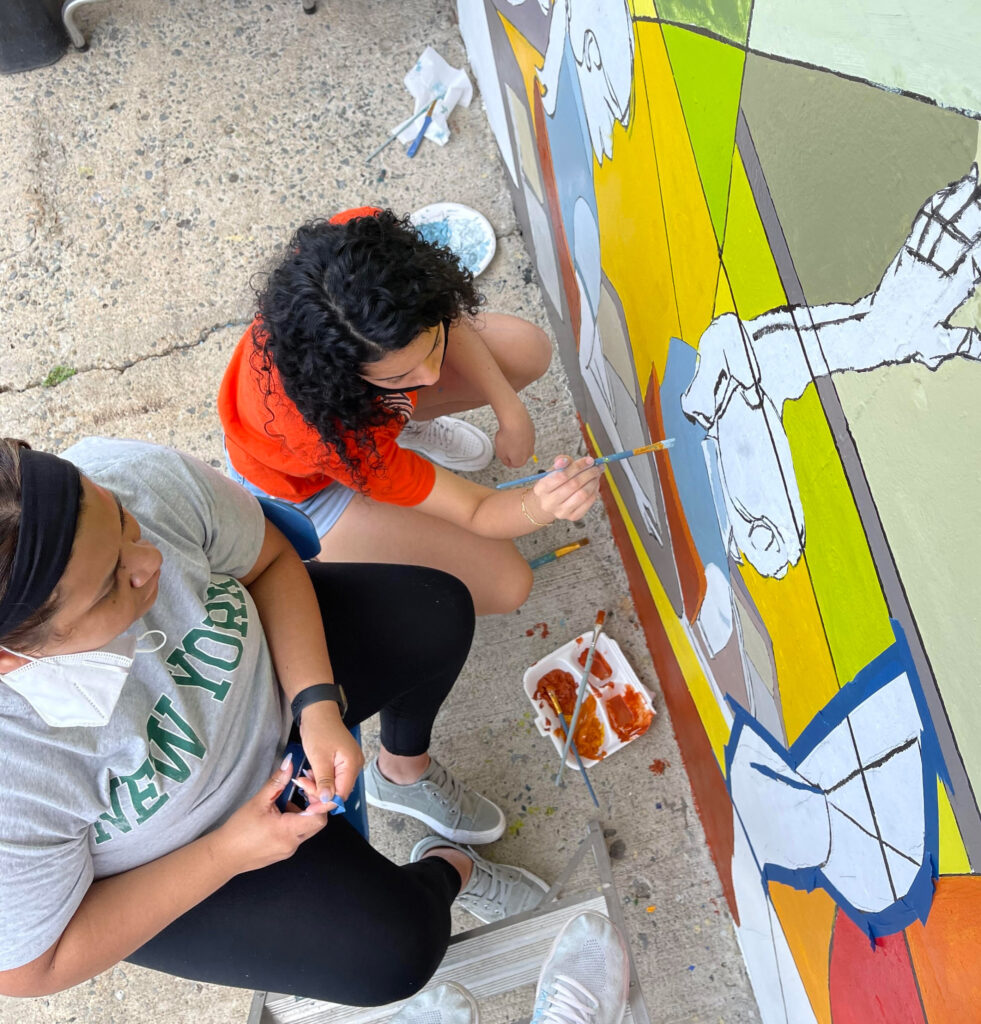
Meanwhile, the teachers at the school were on strike, which the students learned was “a regular thing,” said Cira Merlin, a participant who is going into her junior year at Fordham College at Rose Hill. “As we were painting to show teacher empowerment, how important these teachers are … they’re fighting for their pay,” she said.
The students were hosted by APRODEC, a nonprofit corporation that promotes local, sustainable economic development. They had the chance to tour historic sites, talk with students at the school, and learn about local culture and Puerto Ricans’ pride in their heritage.
“When I talk about this trip, I wouldn’t dare say ‘community service,’ because this was so much more than that,” Merlin said. “We were learning from the school, from the students, from the community. It was so much more than a service trip.”
Because of the project, she said, “I would say my love for education really grew.”
To inquire about giving in support of the Higher Education Opportunity Program, Global Outreach, or another area of the University, please contact Michael Boyd, senior associate vice president for development and university relations, at 212-636-6525 or [email protected]. Learn more about Cura Personalis | For Every Fordham Student, our campaign to reinvest in every aspect of the Fordham student experience.
]]>“Dr. C,” as students and colleagues knew him, served as a professor of economics, the University’s first faculty senate president, and an executive vice president during his 60-year-plus tenure.
“Joe was the beating heart of Fordham. He was supremely competent, tough-minded, and unfailingly kind and generous. He cared for the Fordham community deeply and was intensely loyal to the institution and its faculty, students, and staff,” said Joseph M. McShane, S.J., president of Fordham.
“Until the end, he was deeply involved in University life, and kept in touch with us as much as possible in his gentle but forceful way. We will all miss his sage advice and goodwill.”
Over many years and many leadership roles, Cammarosano contributed to major changes in the University’s finances, governance, and physical expansion.
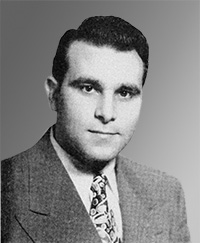
He enrolled at Fordham as a freshman in 1941 and used to joke that he “only missed the first 100 years” of the University’s history. In 1975, on the occasion of his stepping down as executive vice president to return to teaching, James Finlay, S.J., then the University’s president, said, “If Fordham is alive and flourishing today, it is due to no one more than to Joe.”
Cammarosano was born on March 12, 1923, and raised in Mount Vernon, New York. Although he enrolled at Fordham in 1941, World War II interrupted his studies, and he served as a member of the Army Signal Corps until 1945, when he returned to Fordham. He graduated from Fordham College at Rose Hill in 1947 with a degree in economics and went to work as a U.S. customs inspector. After getting a master’s degree at NYU, he returned to Fordham, where he began teaching economics in 1955. He earned a doctorate from the Graduate School of Arts and Sciences in the subject in 1956.
Leadership During Turbulent Years
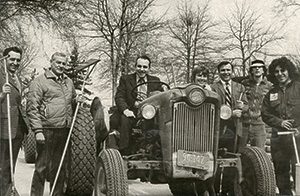
In 1961, he joined the Kennedy administration as an economist in the U.S. Bureau of the Budget, then moved on to the New York State Department of Taxation and Finance. When he returned to Fordham a few years later, he was elected as the first president of the newly formed faculty senate in 1965.
In 1968—a period of financial turmoil for the University—he was named executive vice president. He was one of the key figures in bringing Fordham back from the brink of bankruptcy. That year, the University was operating at $2 million deficit; by 1970, it had been transformed into a $2 million surplus, thanks in part to the advent of Bundy Aid (support for private colleges from New York state), the opening of what became Fordham College at Lincoln Center, and Cammarosano’s fiscal discipline.
Roger Wines, Ph.D., FCRH ’54, a professor emeritus of history at Fordham, served on Cammarosano’s budget committee at the time and worked with him as a member of the faculty senate.
“His committee … was told to cut the University budget 20% in three weeks,” Wines said at a 2015 dinner celebrating the 50th anniversary of the Faculty Senate. “He succeeded in meeting that goal, freezing salaries and hiring, slashing administrative costs and a number of positions. Not one classroom teacher was fired. Financial crisis was averted.”
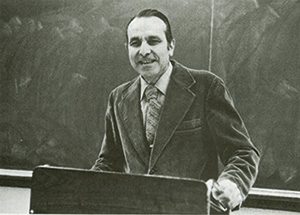
Wines said Cammarosano also played a central role in helping the University make the difficult transition from Jesuit oversight to governance by a board of trustees with several lay members.
“Joe played an effective central role, because he gained the trust of the faculty, of the Jesuit community, and the lay adviser members of the Board of Trustees,” he said.
“That trust was vital in guiding the University through the tumultuous years 1968 to 70, years when the University faced financial bankruptcy, student unrest, religious reform currents relating to the Vatican II Council, and protests against the Vietnam War.”
In an interview with Fordham Magazine in 2015, Cammarosano recalled how his office was occupied by students several times in 1969 and 1970 as protests against the Vietnam War roiled the country.
“The students took over the switchboard at one point, and when someone called for me, they said, ‘No, he’s no longer with us, we fired him.’ I almost wished they had fired me!” he said, laughing.
Monsignor Thomas J. Shelley, Ph.D., professor emeritus of theology and the author of Fordham: A History of the Jesuit University of New York: 1841–2003 (Fordham University Press, 2016), noted that Father Finlay was not engaging in hyperbole when he told the Jesuits’ Superior General, Father Pedro Arrupe, S.J., in 1975 that Cammarosano was “the person mainly responsible for the survival of the University.”
“At a time when we had so much trouble with finances and campus demonstrations, he was a rock of strength,” he said.
“I think it’s true that was the worst financial crisis the University ever experienced. It was a time when the South Bronx was burning, and it had made it up to Fordham Road, so that was another factor.”
A Dynamic Teacher with Boundless Energy
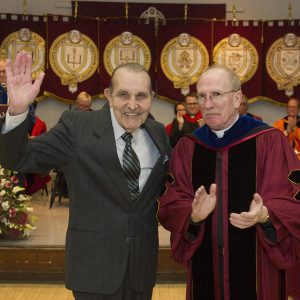
In 1976, Cammarosano was honored at the University’s faculty convocation as an “exacting taskmaster” who earned his students’ appreciation by preparing “meticulously” and lecturing “dynamically.” Cammarosano served as executive vice president twice; the second time was to assist the newly appointed president of the University, Joseph A. O’Hare, S.J., who took office in 1984. But he returned to teaching once again.
E. Gerald Corrigan, GSAS ’65, ’71, a managing director of Goldman Sachs and a former president of the Federal Reserve Bank of New York, studied with Cammarosano during the 1960s, helping him produce economic studies of the Bronx and the Brooklyn Navy Yard.
“He’s a dynamo,” Corrigan told Fordham Magazine, recalling how his mentor would deliver “two-hour lectures nonstop at a fevered pitch.”
In 2017, when Cammarosano—then in his 62nd year as a member of the faculty—received an honorary degree at the University’s 172nd Commencement, his citation noted “the personal attention that he gives his students in the classical Jesuit model of cura personalis.”
Dominick Salvatore, Ph.D., a distinguished professor of economics who first met Cammarosano when he joined the economics faculty in 1971, remembered him as a gentleman, scholar, and all-around wonderful human being.
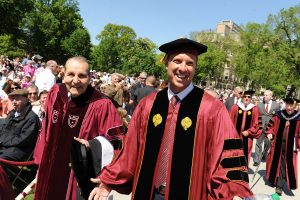
“The greatest compliment that students could pay to me was for them to tell me I reminded them of Joe Cammarosano,” he said.
“The students loved him and he was a rigorous teacher. He demanded things but was always jovial. I’m no young spring chicken myself, but very often I had to remind myself that I was talking to an over-90-year-old person because it was so easy to assume he was 65 or 70,” he said.
Mary Burke, Ph.D., a senior lecturer of economics, said that when one spoke to Cammarosano, he was so full of life and energy, one could be forgiven for assuming he’d be around forever.
“His office is next to mine, and every day he had classes, his office door would be open. He would be there until 5, 6, or 7 p.m. As long as there was a student who wanted to ask a question or just talk, he would be there for them,” she said, noting that conversations related to the Yankees could go on especially long.
“I met Dr. Cammarosano when I was a student. Now, I have known him as a mentor, advisor, and a dear friend.”
Cammarosano continued to teach well after many peers had retired, most recently in the fall of 2018. He submitted his formal letter of retirement in February. Matthew McCrane, GABELLI ’19, took Introduction to Macroeconomics with him, and recalled the boundless energy that belied his age.
“It was a privilege to have been taught by someone who has taught so many alumni before me. It was like I was experiencing a staple part of Fordham. In a way, it’s like I can connect with much older alumni as a result of having had him in class,” he said.
Making a Mark as an Administrator
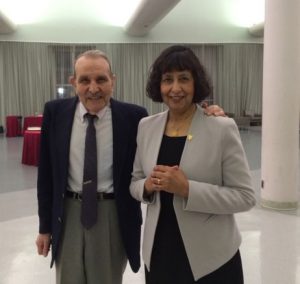
Stephie Mukherjee, assistant dean and director of Fordham’s Higher Education Opportunity Program at Rose Hill (HEOP), called Cammarosano a “giant” and “Father of Fordham” for his outsized influence on the University. He was responsible for bringing HEOP to Fordham when the state program was created in 1969, and on numerous occasions, he stepped in to save it when funding was threatened, she said.
“He believed in the students, he believed in the underprivileged, he believed in people, and I’m grateful that he believed in me. He knew that this job is my passion, it’s not just a job,” she said.
“He was such a kindhearted, warm, wonderful person. He touched so many people’s lives.”
Sheldon Marcus, Ed.D., professor of educational leadership at the Graduate School of Education (GSE), recalls trying to get funds approved by Cammarosano in the 1970s to reimburse an administrator for weekend hours spent working. The paperwork for the request came back with Cammarosano’s bold script: “Rejected.”
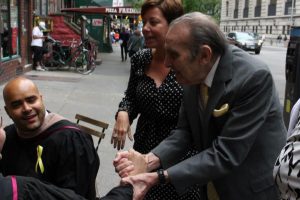
When he went to see Cammarosano in his office, Marcus was greeted with more colorful language that seemed to indicate his case was lost. But then Cammarosano asked for the papers back, scratched out “rejected,” and added, “approved.”
Marcus said he started to leave, “happy to walk out of his office with my head still on.” But Cammarosano said, “Wait a minute.” He put his arm around Marcus and said, “Shelly, you’ve been working too hard, go home this weekend and don’t do another thing; get some rest.”
“He was just the most humane guy behind that tough rough exterior,” said Marcus. “It has been a pleasure to be at Fordham because of people like him; he just made it family.”
Family Above All
Cammarosano’s daughter Nancy Hartzband, FCRH ’77, LAW ’83, said her father was very connected to his own family, including his five grandchildren.
“I think it was such a good relationship because he dealt with young people his whole life, which he loved. He knew them one on one, he guided them, he was a very important figure in each of their lives,” she said.
“He set the bar really high for all of us in terms of morals. Whenever I’m in doubt, I ask, ‘What would my dad do?”
She too marveled at his stamina, noting that two years ago he published An Overview of the Development of Economic Thought (Lexington Books, 2018), the last of his three books about the ideas of economist John Maynard Kenyes.
“I mean, who does that? At that age, I’ll be happy to be sitting in my rocking chair,” she said laughing.
“But that was him. He always wanted to learn, he always wanted to do something new.”
Cammarosano still had an apartment in his native Mount Vernon, she said, but had recently moved in with his son in Island Park, New York.
She said her father was a devout Catholic who maintained his connection to Fordham for eight decades because he believed strongly in its Jesuit mission.
“We always knew we were very special because of the person he was at the University,” she said.
“He was just an incredible presence in our lives. He was almost larger than life.”
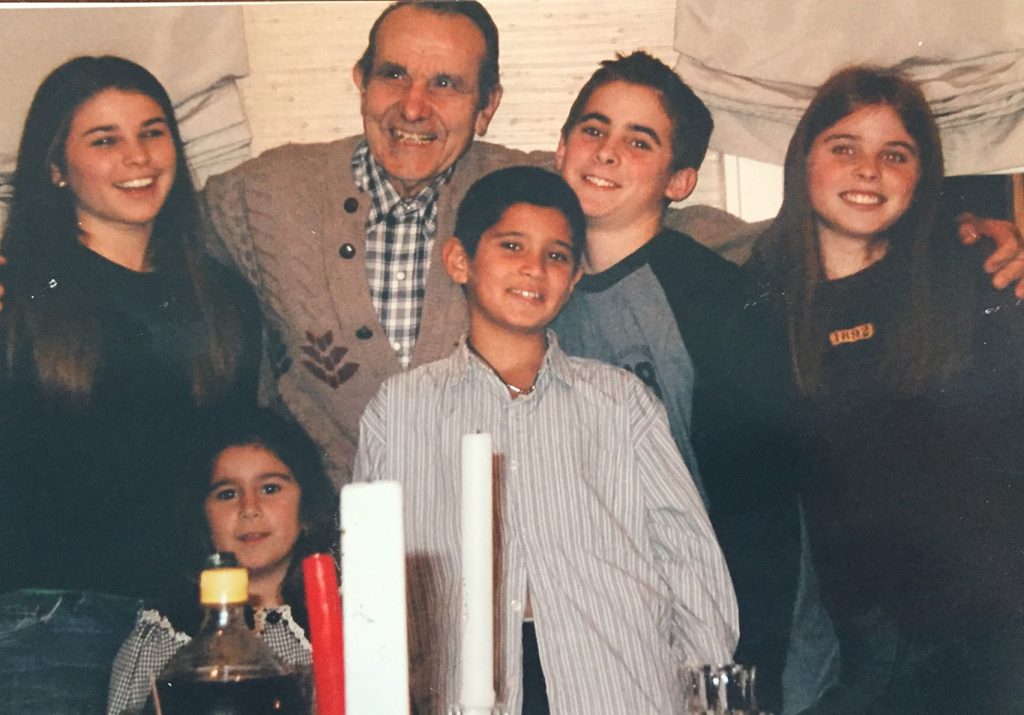
“I think it was such a good relationship because he dealt with young people his whole life, which he loved.,” said his daughter, Nancy. Photo courtesy of Nancy Hartzband
Cammarosano is survived by Hartzband and her three children as well as his son, Joseph R. Cammarosano, FCRH ’78, LAW ’81, Joseph’s wife, Mary, and their two children. Two of his grandchildren are alumni as well: Danielle Cammarosano, GABELLI ’19, and Alex Hartzband, LAW ’15. Cammarosano’s wife, Rosalie, died in 1991 and his son Louis T. Cammarosano, FCRH ’74, LAW ’78, died in 2014.
He was interred at the Gate of Heaven Cemetery in Hawthorne, New York, after a private funeral service. The University will also hold a memorial mass in his honor at a date in the future.
To hear Cammarosano talk about working and living in the Bronx over the years, listen to his interview with the Bronx Italian American History Initiative.
—Tom Stoeker contributed reporting.
]]>Beginning with the fall 2020 application cycle, Fordham will meet up to the full cost of tuition for Cristo Rey Network students admitted to the University through either the traditional full-time admission process or the Higher Education Opportunity Program (HEOP-NY State).
“We’ve been working as partners with Cristo Rey for many, many years. This is an opportunity for us to take that commitment to a new level and help make a private education more affordable and possible for some of those students,” said Patricia Peek, Ph.D., dean of undergraduate admission at Fordham.
The Cristo Rey Network is a group of 37 Catholic high schools across the U.S. that primarily serves students from low-income families. What makes the network unusual is its four-year corporate work-study program, featured on 60 Minutes in 2004. Students balance their classes with entry-level jobs at local businesses. They gain work experience and earn money that goes directly to the school to cover part of their tuition.
Extending A Decade-Long Relationship
For more than a decade, Fordham has shared strong ties with the network’s schools, many of which are Jesuit-affiliated. Cristo Rey students have read their poetry at Fordham’s Poets Out Loud series. Fordham Founders Stephen E. Bepler, FCRH ’64, and John Ryan Heller served as trustees at Cristo Rey schools in East Harlem and Chicago, respectively. And the founding president of Cristo Rey New York High School, Joseph P. Parkes, S.J., JES ’68, served as a Fordham trustee and received an honorary degree from the University in 2019.
The University is especially close to Cristo Rey New York High School. Located in East Harlem, the school has sent more students to Fordham than any other school in the Cristo Rey network. Since the school graduated its first class in 2008, at least one student has come to Fordham each year, for a total of 69 enrollees in the last 11 years, said Peek.
“Every year, we always get a ton of students saying, ‘We’re applying to Fordham. We want to really get in, and what can we do to get there?’” said Martha V. Fermín, director of college guidance at Cristo Rey New York High School and a 2011 graduate of the school. “I really hope that this [partnership] continues to flourish in many ways, and we can continue to collaborate in any way possible.”
The East Harlem school was profiled by The New York Times in 2007. A year later, the second Cristo Rey school in New York—Cristo Rey Brooklyn High School, formerly known as Lourdes Academy High School—opened. Fordham has had nine enrolled students from the Brooklyn school.
The University’s new financial pledge can also make a difference for Cristo Rey students outside of New York who aren’t candidates for the Higher Education Opportunity Program (HEOP-NY State), which provides eligible students with educational support services and additional financial assistance.
“By expanding our funding opportunity, we’re hoping this will help make a Fordham education possible for Cristo Rey students at a distance,” Peek said.
‘It Touches Me Deeply’
News of the agreement caught the attention of Jordi Giler: a Cristo Rey alumnus, junior at Fordham College at Rose Hill, and HEOP student. His younger sister is currently a senior at Cristo Rey New York High School who recently applied to Fordham, he said.
“[The new pledge] eliminates one of the greatest burdens that a kid has, going into the college process, which is money,” said Giler, a political science major from the Bronx who wants to work in immigration policy reform. “A lot of kids from Cristo Rey—me and my sister included—we don’t come from rich homes. We come from traditionally lower-class or middle-class homes, where one of the main concerns about going to college is, are they giving me enough money? Do we have to take out loans?”
For Emely Mojica—a Cristo Rey alumna, sophomore at Fordham College at Rose Hill, and HEOP student—the new pledge is a powerful one.
“It touches me deeply. I’m the eldest of five children, and I’m the first in my family to go to college. I’m able to be at Fordham because I’m here on three scholarships,” said Mojica, an English major from the Dominican Republic who wants to work in corporate communications. “It’s going to be so much more helpful and accessible to receive higher education, especially for Cristo Rey students who I know deserve it and work so hard.”
To apply to this new program, Cristo Rey students should apply to Fordham with the Common Application and complete the University’s standard financial aid process.
]]>They were married in 2007. Though they never overlapped at Fordham—Trevor graduated in 1999 and Antoinette in 2003—they agree that there was a comfort in being with someone who “shared the same passion and pride for the place we attended college.” In fact, for their second date they chose to see Man on Fire. “The reason,” says Trevor, “is because Denzel Washington [the film’s star]went to Fordham!”
“Trevor was the first person I met who understood the importance of my staying connected to Fordham and my high school volunteer work,” Antoinette says. “People wearing ‘F’ hats and shirts are popular in our lives.”
Fordham Beginnings
The couple first came to Fordham from opposite coasts. An Astoria native, Antoinette says the University has always been a presence in her life. She grew up knowing family members, neighbors, and teachers who are Fordham alumni. But it wasn’t until she toured the Rose Hill campus during her senior year of high school that “I knew I’d found my home,” she says.
“At Fordham, I was not just a number but an actual person,” says Antoinette, who commuted to campus. When her parents would pick her up at the Bathgate Avenue entrance, Joseph A. O’Hare, S.J., then president of Fordham, “would come over to say hello and have a conversation,” she recalls. “I don’t think presidents at other schools do that.”
Growing up in Novato, California, Trevor didn’t know much about Fordham until he was recruited for the water polo team. Now a managing director at Signature Bank, he says that Fordham “turned out to be a tremendous call” in terms of his experience as a student-athlete, financial aid support, and an education that “set me up for success in the world of finance.”
Giving Back
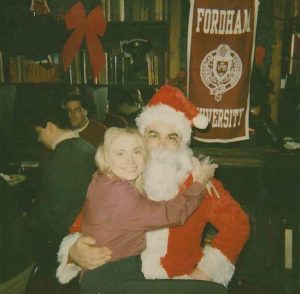
Together and individually, Antoinette and Trevor have spent a lot of time supporting Fordham causes. They were both longtime active members of the Young Alumni Committee—an advisory and programming board for graduates of the past 10 years—and advised students through the Fordham Mentoring Program. Trevor still supports the water polo team. And together they’ve supported HEOP, the Ailey/Fordham BFA in Dance program, and Founder’s scholarship students; participated on Jubilee reunion class committees; and supported several athletics programs.
A newer family tradition is attending Fordham games on campus as well as regional alumni chapter events around California, on Long Island, and in Westchester with their daughter, 3-year-old Aria. Antoinette is a self-employed accountant who works from home to be with her.
“I know how important it is to help our future leaders of tomorrow, and I love volunteering with people and collaborating to improve,” Antoinette says.
Shared Roots
Besides being passionate about similar causes, the couple shares a certain Fordham mentality that they say brings strength to their marriage.
“A Jesuit education and the Fordham experience definitely provides us with a core of our relationship. We choose to live and lead by example,” Antoinette says. “Marriage is a mix of individual and teamwork. That’s why I say you should find ‘the partner,’ because ‘the one’ is not realistic. Find someone who supports you, helps you be happy, and is open to you and the inevitable change that happens.”
Trevor agrees. “I think one of our strengths is that we both realize when something is important to the other person, and we support that,” he says.
“Plus, we are both big Star Wars and Marvel fans.”
Fordham Five
What are you most passionate about?
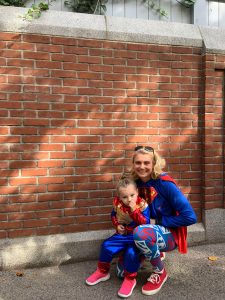
Antoinette: I love being a mom to a toddler. I recognize that I’m her role model, even her caped crusader—sometimes I wear a cape! I set an example for her in the only way I was taught—through volunteerism and advocacy work on social justice projects. It’s the change for the greater good. Yes, I’m also an accountant. But I say I do accounting for fun and my real job is volunteering. I like knowing that Aria can look back and see results of what I did to make the world better for her generation.
Trevor: I’m most passionate about my daughter, Aria. The best part of my week is watching her progress in swimming, and now mixed martial arts. She is only 3 and has been promoted into a swim class with 5-year-olds! She has zero fear of the water and can already swim about five yards by herself if I let her go. If I tie a noodle around her, she can swim an entire length in a 25-yard pool.
What’s the best piece of advice you’ve ever received?
Antoinette: Jeff Gray, my former work-study boss at Fordham [who is now senior vice president for student affairs], once told me that sometimes when you become overwhelmed by everything happening, you focus on one thing and forget to see how things work and affect each other—the big and little pieces. You need to learn to step back and then look in at the big picture, he said. Only then can you fully see what you are missing.
Trevor: My junior year of high school, my water polo coach told me that a big shot is just a little shot who kept shooting. I know it is a famous quote [by writer Christopher Morley], but that was the first time I had ever heard it. Playing sports teaches you a lot of things, but for me the most important is to never be scared to shoot your shot.
What’s your favorite place in New York City? In the world?
Antoinette: In New York, it’s Rockefeller Center and the tree. I’m probably biased since it’s where my first full-time role was after graduating from Fordham. It’s also where my husband picked me up for our first lunch date. It’s a place that everyone in the world is drawn to visit. Now we take our daughter to visit the tree annually. It’s a nod to how places that are so chaotic or crowded can still be symbols of faith in the holidays, togetherness, and our own true wish that something better will come in the next year.
My favorite spot in the world is walking the beach and watching the sunset in Waikiki. They have fireworks on Friday nights at the Hilton Hawaiian, and I think it’s gorgeous to sit in the sand and watch the waves hitting the beach while the cool air gently blows. Trevor’s grandparents lived there for more than 30 years, and we would go every summer when we first got married. Hopefully we’ll return this fall for the Fordham football game.
Trevor: My favorite places in New York are Astoria and Fordham. Both places just kill it from a restaurant standpoint. I would say that Bahari Estiatorio in Astoria is hands down the best Greek restaurant on the planet, and Omonia is the best bakery in New York City; its baklava cheesecake is ridiculous. Fordham obviously always means a lot to me. I love the campus; it just always seems warm and inviting. Being a water polo player, the uniqueness of having a 38-meter pool is now something I smile about as well. Most pools are either 25-yard short-courses or 50-meter long-courses. NCAA Division I and international water polo are played at 30 meters, so Fordham’s unique pool still works.
Like Antoinette, my favorite spot outside of New York is Hawaii, specifically Waikiki. My Oma and Opa lived there for basically my entire childhood and through my early adult years. Perfection is sitting with a Mai Tai in the beautiful Hawaiian sun!
Name a book that has had a lasting influence on you.
Antoinette: Gone with the Wind shows how you can go from rich to poor, poor to rich, but still have faith and a fire within to excel. Life is full of trials and tribulations. It’s not life if you can’t take the ups and downs. It takes perseverance to stay focused and overcome in order to build or rebuild. You always need to be able to self-reflect and be grateful for who and what you have in your life. Sadly, Scarlett was not able to find balance between work and life. She was always focused on someone else, but he was not worth all of the effort she spent trying to win his love. Scarlett had everything and lost the one who loved her the most. But with conviction, she concludes that she will get him back.
Trevor: I read a lot of books, but this is a tough question. It’s not my favorite, but the book I read as a kid and read again recently that probably stuck with me the most is Great Expectations by Charles Dickens. I think as you rise up the ladder, it’s important to keep the lessons that Dickens tried to impart in the back of your head.
Who is the Fordham grad or professor you admire most?
Antoinette: Joseph Cammarosano, longtime professor of economics. He taught us that “it’s not about making a living, but making a life worth living.” He helped New York state create the Higher Education Opportunity Program (HEOP) for academically and economically disadvantaged students, an invaluable program to those who qualify. I credit much of my passion for volunteerism, philanthropic efforts, and even political focus, especially in education, to Dr. C’s teaching. I don’t think you can get more Jesuit than him inspiring others to follow the core principle of men and women for and with others. I also love and admire Donna Rapaccioli [now dean of the Gabelli School], not just as my former accounting professor but for the exemplary woman she is ethically and for all of the amazing relationships and advancements she has created and continues to grow (work in progress). I hope to see more women in business, especially finance!
Trevor: Another tough question. My favorite professor at Fordham was a history professor named Robert Jones. While my concentration was finance, I have always loved history. I think I took all of my electives in classes that he taught.
]]>When he was only 3 years old, a military coup forced Osman and his family to flee their native Sudan. After short stints in several Middle Eastern countries, the family joined Osman’s uncles in the United States and settled in the Bronx, where they had to start over again financially.
“We were fortunate, but we were also pretty humble while I was growing up, and it gave me a different perspective on many things,” Osman says. It also meant that being accepted to Fordham College at Rose Hill with financial aid and support from the Higher Education Opportunity Program (HEOP) was a huge relief to him and his family.
Entering college undecided about his major, he stumbled onto economics while fulfilling a core curriculum requirement.
“I was always good at math, but I wasn’t necessarily a fan of it, because I questioned the need for all the formulas. This class gave me a reason to apply those formulas and logic,” he says. “Economics included politics. It included math. It was everything I loved.”
Now an associate and global alternatives product specialist at JPMorgan Asset Management, Osman traces his professional success back to that Jesuit curriculum and to his first work-study job in Walsh Library, part of his financial aid package. “I had jobs before,” he says, “in fields like retail, education, and politics. But that was really my first office type of experience. And that eventually helped lead me to the Office of Career Services, where I really learned what I wanted to do and where I wanted to be.”
After several internships, he landed a position in a two-year rotational program at JPMorgan right after graduating in 2014.
“I owe a lot to Fordham, and that’s why I give back however I can. There’s a kid in my shoes out there, a kid from the Bronx who isn’t afforded the luxury of being able to pay for college, and that sucks,” Osman says. “We should be able to help them out.”
Osman has helped by contributing to scholarship funds at Fordham, sponsoring receptions for Fordham alumni who work at JPMorgan, and participating in events run by MOSAIC, Fordham’s multicultural alumni affinity chapter.
In 2016, he joined the advisory board of the newly formed Fordham University Alumni Association (FUAA). The thing he’s most proud of is helping launch the Alumni Career Fair with fellow members the FUAA’s networking and engagement task force. It’s an opportunity for alumni to network with each other and with the University’s employer partners.
“We were lucky to go to an institution that focuses on job placement, on interview training … and that takes a true career-oriented approach,” he says.
Osman is committed to enhancing that support by creating opportunities for Fordham alumni who have not yet found the right path, or for those ready to take the next step. The third annual Alumni Career Fair will take place at the Lincoln Center campus on March 4. More than 100 alumni of all levels of experience have already signed up for this year’s event, and more than 25 employers across industries—some of which will be sending Fordham alumni as representatives—are set to attend.
“It’s amazing to see this event materialize, to help arrange this forum for alumni relationships,” he says.
Fordham Five
What are you most passionate about?
I would say philanthropy, honestly. Just giving back in general. It’s always been a pillar of mine. Not only does it help other people who are less fortunate in whatever situation, but I think it’s a good reminder of what you’re afforded in life, to be grateful for what I have and understand that there are others without these opportunities.
What’s the best piece of advice you’ve ever received?
One of the first memories I have is from when I was 3 years old and we were leaving Sudan. It was the first time I had been on a plane. I was with my father and I said, “Oh wow, I get to go on a plane!” My dad looked at me and said, “You know, yeah. Enjoy it. Experience it. But also be grateful for it.” At the time, I was so young that it kind of went over my head. But I’ve realized that the idea has grown with me. I think my dad wanted me to enjoy the moment while also being mindful that it was a privilege to experience something like that, especially considering other folks’ less fortunate circumstances (regardless of how unfortunate our own circumstances may have seemed). Now that’s become part of my normal thinking. Aim for the best, listen and be present in it, and enjoy what you have. It’s a way to see through that bubble, that privilege bubble, that everyone has in some way.
What’s your favorite place in New York City? In the world?
Would it be cheating if I said Fordham’s Rose Hill campus is my favorite place in New York City? I don’t want to be cheesy, but honest to God, I was awed during my first visit to campus. I grew up in the Bronx, in a very urban environment, and to walk onto that campus and see this beautiful place with unbelievable landscaping and immaculate Gothic architecture … I was like, wow. And every time I’m there, I have to take photos. I love it. Especially that walk from Dealy Hall toward the library, with that view of Martyrs’ Lawn and Walsh and Duane. You couldn’t get more picture perfect. That’s the image I think of when I picture campus. And the fact that it’s in the Bronx just makes it much sweeter for me.
As for my favorite place in the world, this might be mainstream, but it’s Paris. I’ve been four times total, twice for work in the past year. I can’t speak a lick of French, but I love it. It’s a romantic city, and it’s truly beautiful. There’s so much history behind it, so many sites to see, intricate neighborhoods … it reminds me of New York because it has its own little districts that are each their unique environments, and you can find something interesting in each one.
Name a book that has had a lasting influence on you.
So, I have two, and they’re both a bit controversial.
The first is The Autobiography of Malcolm X. And the second is The Art of the Deal by Donald Trump. I know, big contrast.
What’s important about Malcolm X … I wasn’t born here, my family hasn’t been in America for hundreds of years. We’re from Africa directly. But I grew up in New York, and I still connected with many of the experiences in the book. His logic for a lot of things, obviously, was a little too extreme. But in the latter part of his life, he was much more welcoming. It taught me about perspective, and how when you’re given new insight you can vastly change your initial perspective. In the beginning of his conversion to Islam, for example, he had a much more conservative position. And then he started to travel and interact with more folks and realized that’s not all this religion is about. He evolved. He actually visited Sudan, and that was one of the reasons I decided to read his book back when I was 12. And I’ve read it every five years since then.
And then for Art of the Deal, I don’t necessarily agree with his political views, but I just think business is always impressive to me. It’s very hard to make it, to be a very successful businessperson. And when someone does it, even if they started with money, it’s impressive. I first read that when I was 14, I think. It really taught me about the passion you have to have, the kind of work ethic you have to have, the things you have to think about, or the kinds of decisions you have to make to progress. From a career or networking perspective or just from a personal development perspective, it’s important to understand how to make your argument, how to weigh your options. I’ll be frank: A lot of the book is self-promotion. But there are some key things in there, and those left a lasting impression on me.
Who is the Fordham grad or professor you admire most?
This might be another mainstream answer, but Denzel Washington. For me, the fact that this guy, a New York guy from Mount Vernon who went to Fordham, found his calling and his craft, and followed through with that and became the success he is today, and also remains a good family man, that means a lot to me. Not that I’m anywhere near the guy, but that’s a good person to look up to and aspire to be like. That’s my favorite Ram.
Though the March 6 event’s setting was decidedly big business, the student and alumni participants hailed from a variety of disciplines.
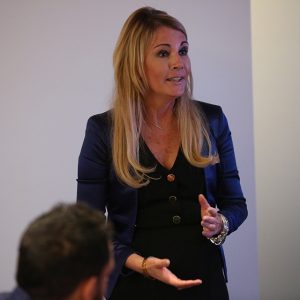
Photos by Bruce Gilbert
Fordham College at Rose Hill junior Sherika Christopher said she had researched the mentors before coming. The CSTEP student, who is following a premed concentration, was looking forward to meeting up with Gene Caiafa Jr., D.D.S. FCRH ’91, who has an established family dental practice in Queens.
“I’d like to talk to Dr. Caiafa about how he got to where he is,” she said.
Josephine Fernandez, a HEOP and CSTEP junior at Fordham College at Lincoln Center, is studying social work. She said that networking among a variety of professionals is as key to becoming successful as a social worker as it is to other professions.
“Whether it’s opening your own private practice or just getting a message out, networking is always important,” she said. “Advocacy is also a big part of social work [and]a lot of folks who come to events like this support a lot of charities.”
Patsy Doerr, GSE ’96, Thomson Reuters’ global head of corporate responsibility and inclusion, welcomed the students and told them to be strategic and “network with a purpose.”
“Get out there—but not in a mercenary way,” she said. “When you go to an event, make sure you get two or three business cards . . . and that’s enough. If you get 15, you’re not going to be able to follow up with all those people.”
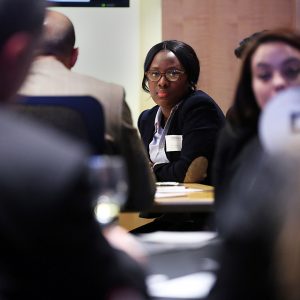
Doerr also advised students to be honest with themselves about what they do well and what their shortcomings are.
“Know what you’re good at and have a really quick narrative of what those two or three things are,” she said.
Lastly, Doerr told the students, especially the women in the room, to take risks.
“There’s a lot of data out there that [says]women take less risks than men,” she said. “I’m not suggesting that every woman in this room falls into that category, but make sure you take as many risks as you’re comfortable with.”
She said that she understood that many well-intentioned bosses often make assumptions about their employees. She told students that if they find they are being misjudged to respectfully set the record straight.
“I was getting a performance review and I said to my supervisor, ‘Please don’t rule me out for an international assignment just because I have two young babies,’” she said. “He later called me and said, ‘How would you like to go to Hong Kong?’”
Several alumni agreed that preconceived notions are something that everyone in the room had to battle against at one point or another.
“I was a HEOP student and you hear these things about HEOP and CSTEP students being disadvantaged—but they’re not academically disadvantaged, they’re financially disadvantaged,” said Anthony Carter, FCRH ’76. “People have this misconception that CSTEP or HEOP students got in by the skin of their teeth. No, I got in academically. I had some issues financially. Events like this give us alumni an opportunity to help students navigate beyond that role.”
